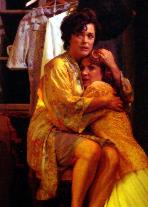A Streetcar Named Desire
Dates: 13 - 30 January 2005, 8pm Venue: Norman Rothstein Theatre
Reviewer: John Jane
 |
|
Lucia Frangione and Gina Chiarelli |
When Tennessee Williams’ masterpiece, A Streetcar Named Desire, opened on Broadway in December, 1947, it immediately ignited the careers of two icons of American theatre: Williams himself and leading actor, the then 23 year old Marlon Brando.
Last Fall, the same play was presented at the Chemainus Theatre Festival. Such was the production’s success that director Jeremy Tow felt encouraged to transport the entire cast and crew complete with all the design elements for a repeat run at the cozy Norman Rothstein Theatre.
Originally given the even more metaphorical title, Blanche's Chair on the Moon, A Streetcar Named Desire recounts the story of the emotional demise of the outwardly demure, yet fragile, Blanche DuBois (Gina Chiarelli) when she moves to New Orleans and into the squalid apartment of her married, younger sister Stella (Lucia Frangione) and crude, belligerent brother-in-law (Craig Erickson).
Streetcar presents a tremendous challenge for those who would revive it. Not least because of the obvious comparisions with the iconic performances of the play's central roles given in Elia Kazan’s seminal film version.
Of the two leading players in this production, only Ms Chiarelli proves to be equal to the task. She invests in Blanche the pathos of vain denial and makes her sympathetic, coquettish and even possessing a hint of humour.
r
e
v
i
e
w
V
a
n
c
o
u
v
e
r
.
o
r
g
Craig Erickson offers a physical performance as Stanley Kowalski, but lacks the menace that a Stanley must exude. He substitutes loudness for malevolence and seems an unwitting agent in Blanche’s eventual destabilization.
Lucia Frangione as Stella and Craig March as Blanche’s oafish suitor, Mitch have a much better handle on their far less difficult roles. Though, I found the most entertaining performance of this production is given by Olivia Olson in the small role of Stella's neighbor Eunice Hubbell. Others in the cast, particularly Mark DuMez and Jack Paterson as Stanley’s poker buddies round out an excellent supporting cast.
Carole Klemm’s set design and Rebekah Johnson’s lighting manage to recreate the stifling confinement of the Kowalski’s two room apartment at 632 Elysian Fields and make it fit onto a small stage without it seeming at all cramped.
Tobin Stokes sound design fits so well it's barely noticeable. The plaintive rendition of “Sometimes I Feel Like a Motherless Child” that opens the first act primes the audience to the gritty atmosphere of New Orleans French Quarter.
After nearly sixty years, little appears to slow Streetcar’s momentum. It’s perhaps easy to understand why it's universally recognized as a coup de theatre. Long after leaving the theatre we can still hear Stanley’s anguished cries of “Stell--aaa--hh!”
© 2005 John Jane